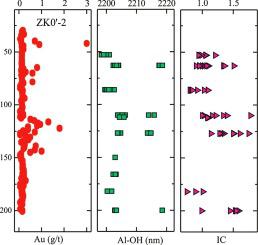Ore Geology Reviews ( IF 3.2 ) Pub Date : 2021-09-11 , DOI: 10.1016/j.oregeorev.2021.104463 Bing Xiao 1, 2 , Gaobin Chu 1 , Yuzhou Feng 1

|
The Laowangou gold deposit is a newly discovered Au deposit in the North Qinling orogenic belt. Based on megascopic and microscopic textural relationships and mineral assemblages, the hydrothermal alteration and mineralization of the Laowangou Au deposit have been divided into porphyry-type (including potassic, chlorite-epidote and mica-quartz alteration stages) and overprinting mineralization periods. Hypogene Au mineralization mainly occurred as muscovite + quartz + Au-bearing pyrite veins during the overprinting mineralization period, and developed in the fault and fracture zone. SWIR analyses indicate that alteration minerals in the Laowangou Au deposit are chlorite (including Mg chlorite, Fe chlorite, and Fe-Mg chlorite), epidote and white micas with less dolomite, brucite and calcite. Two types of white mica are recognized at Laowangou. Type A white mica partially replaces plagioclase and K-feldspar in the Tangzang quartz diorite, representing the mica-quartz stage, whereas Type B white mica coexists with Au-bearing pyrite, quartz, calcite, and mainly developed in the fracture zone, representing the overprinting mineralization period. Compared with metamorphic minerals, Laowangou porphyry-related chlorite shows lower Al, Ti, and As, but higher Sr concentrations; porphyry-related epidote has higher Ti and Bi, but lower As concentrations. Type B white mica has lower Fe and Mg contents, but larger particle sizes and illite crystallinity (IC) values than Type A white mica, similar to geochemical characteristics of metamorphic white mica. These evidences indicate the Laowangou Au mineralization is different from typical magmatic-hydrothermal Au deposits, and the ore-forming fluid related to Au mineralization may have derived from the depth along faults. Higher wavelength of the Al-OH absorption (>2210 nm) and IC values (>1.2) of white mica can be used as effective vector toward high grade Au mineralization (>1 g/t) in the Laowangou Au deposit.
中文翻译:

老王沟金矿床热液蚀变矿物的短波红外(SWIR)光谱和地球化学特征:对矿石成因和矢量化的意义
老万沟金矿床是北秦岭造山带新发现的金矿床。根据宏观和微观结构关系和矿物组合,将老王沟金矿床热液蚀变和成矿划分为斑岩型(包括钾化、绿泥石-绿帘石和云母-石英蚀变阶段)和叠印成矿期。下近系金矿化在叠印成矿期主要以白云母+石英+含金黄铁矿脉为主,发育于断层和断裂带。SWIR分析表明,老王沟金矿床的蚀变矿物为绿泥石(包括绿泥石镁、绿泥石铁和绿泥石铁镁)、绿帘石和白云母,白云石、水镁石和方解石较少。老万沟有两种白云母。A型白云母在唐藏石英闪长岩中部分替代斜长石和钾长石,代表云母石英阶段;B型白云母与含金黄铁矿、石英、方解石共存,主要发育在断裂带,代表套印矿化期。与变质矿物相比,老王沟斑岩相关绿泥石的Al、Ti、As含量较低,Sr含量较高;与斑岩相关的绿帘石具有较高的 Ti 和 Bi,但较低的 As 浓度。B型白云母具有较低的Fe和Mg含量,但比A型白云母具有更大的粒径和伊利石结晶度(IC)值,类似于变质白云母的地球化学特征。这些证据表明老万沟金矿化不同于典型的岩浆热液金矿床,与金矿化有关的成矿流体可能来自沿断层的深度。白云母较高的 Al-OH 吸收波长 (>2210 nm) 和 IC 值 (>1.2) 可作为老王沟金矿床中高品位金矿化 (>1 g/t) 的有效载体。











































 京公网安备 11010802027423号
京公网安备 11010802027423号